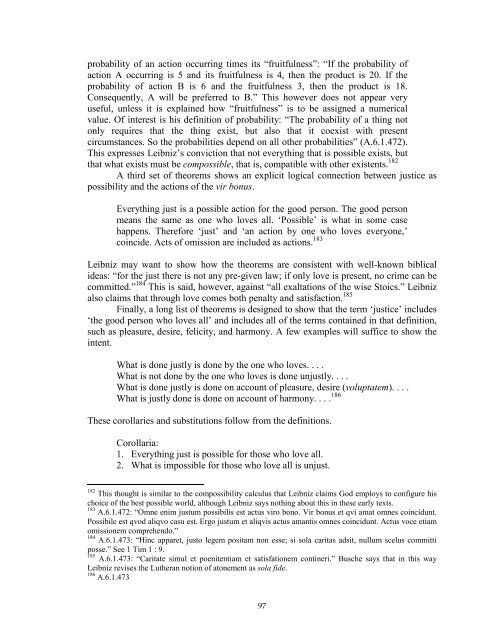Stony Brook University
Stony Brook University
Stony Brook University
You also want an ePaper? Increase the reach of your titles
YUMPU automatically turns print PDFs into web optimized ePapers that Google loves.
probability of an action occurring times its “fruitfulness”: “If the probability of<br />
action A occurring is 5 and its fruitfulness is 4, then the product is 20. If the<br />
probability of action B is 6 and the fruitfulness 3, then the product is 18.<br />
Consequently, A will be preferred to B.” This however does not appear very<br />
useful, unless it is explained how “fruitfulness” is to be assigned a numerical<br />
value. Of interest is his definition of probability: “The probability of a thing not<br />
only requires that the thing exist, but also that it coexist with present<br />
circumstances. So the probabilities depend on all other probabilities” (A.6.1.472).<br />
This expresses Leibniz’s conviction that not everything that is possible exists, but<br />
that what exists must be compossible, that is, compatible with other existents. 182<br />
A third set of theorems shows an explicit logical connection between justice as<br />
possibility and the actions of the vir bonus.<br />
Everything just is a possible action for the good person. The good person<br />
means the same as one who loves all. ‘Possible’ is what in some case<br />
happens. Therefore ‘just’ and ‘an action by one who loves everyone,’<br />
coincide. Acts of omission are included as actions. 183<br />
Leibniz may want to show how the theorems are consistent with well-known biblical<br />
ideas: “for the just there is not any pre-given law; if only love is present, no crime can be<br />
committed.” 184 This is said, however, against “all exaltations of the wise Stoics.” Leibniz<br />
also claims that through love comes both penalty and satisfaction. 185<br />
Finally, a long list of theorems is designed to show that the term ‘justice’ includes<br />
‘the good person who loves all’ and includes all of the terms contained in that definition,<br />
such as pleasure, desire, felicity, and harmony. A few examples will suffice to show the<br />
intent.<br />
What is done justly is done by the one who loves. . . .<br />
What is not done by the one who loves is done unjustly. . . .<br />
What is done justly is done on account of pleasure, desire (voluptatem). . . .<br />
What is justly done is done on account of harmony. . . . 186<br />
These corollaries and substitutions follow from the definitions.<br />
Corollaria:<br />
1. Everything just is possible for those who love all.<br />
2. What is impossible for those who love all is unjust.<br />
182<br />
This thought is similar to the compossibility calculus that Leibniz claims God employs to configure his<br />
choice of the best possible world, although Leibniz says nothing about this in these early texts.<br />
183<br />
A.6.1.472: “Omne enim justum possibilis est actus viro bono. Vir bonus et qvi amat omnes coincidunt.<br />
Possibile est qvod aliqvo casu est. Ergo justum et aliqvis actus amantis omnes coincidunt. Actus voce etiam<br />
omissionem comprehendo.”<br />
184<br />
A.6.1.473: “Hinc apparet, justo legem positam non esse; si sola caritas adsit, nullum scelus committi<br />
posse.” See 1 Tim 1 : 9.<br />
185<br />
A.6.1.473: “Caritate simul et poenitentiam et satisfationem contineri.” Busche says that in this way<br />
Leibniz revises the Lutheran notion of atonement as sola fide.<br />
186<br />
A.6.1.473<br />
97
















